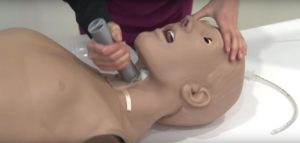Antonio Spina was the team leader of a group of biomedical engineering students at Johns Hopkins University who created CricSpike, an assistive cricothyrotomy device. It is designed to treat airway obstruction in combat. Airway obstruction is the second leading cause of preventable death in combat.

Airway obstruction is one of the leading causes of preventable death in combat. Undergraduate students at John Hopkins University designed a tool to help combat medics succeed in making a life-saving neck incision. (John Hopkins University)
Combat medics fail in cricothyrotomy, or the emergency neck-incision tactic, about one-third of the time. Airway obstruction can cause serious health risks such as brain damage. We also wrote about a blood test that can test for brain injury at the scene of an accident that can be used on people injured in combat.
Undergraduate students created a low-cost, low-tech device to help in the success of combat medics trying to create an artificial airway and pump air into the lungs. The purpose of the device is to keep soldiers alive longer until more advanced treatment can be administered at the hospital. The device is still a prototype, but it has already two won awards at medical device competitions.
Last fall, James Gilman, a retired U.S. army physician, presented the problem of failed cricothyrotomies in combat to his students in the Center for Bioengineering Innovation and Design Teams Program. The students investigated and discovered that the problem lies in that the tools become lodged under the patient’s skin or hit the esophagus, which leads to the stomach not the lungs.
In response to this problem, students designed a tool that extends beyond the skin’s layers but not far enough to hit the esophagus. The device includes an easily removable, two-piece handle that aids in insertion. In a medical mannequin, the students have proven their device works.
The tool requires more refinement before it is tested in human patients. However, it won second prize in the student project category at the Innovation Research Lab Exhibition in Germany in July. In the May 2016 Johns Hopkins Student Healthcare Design Competition, the team won third prize.
The team has also worked with Johns Hopkins Technology Ventures to obtain a patent for the components of their CricSpike tool.
“The students did a great job,” said the project’s sponsor Gilman. “But the final prototype was still pretty rough. Relying on 3D printing techniques could only get them to a certain level. The next step in the development process would have to involve production of a more professional prototype.”
The students who return to Johns Hopkins in the fall plan to build a more refined design to help people in combat deal with airway obstruction. They hope to obtain a medical license where it could be incorporated in a kit in combat.

